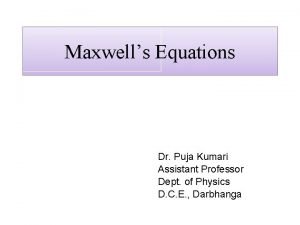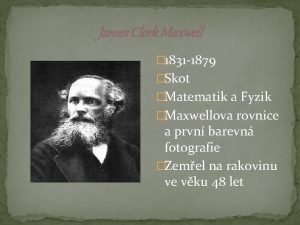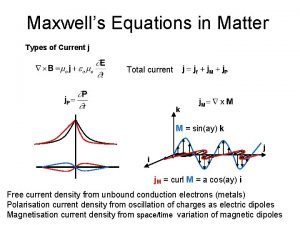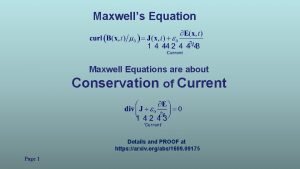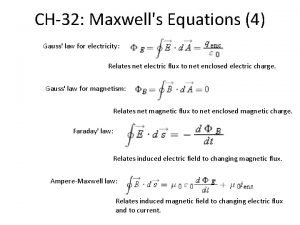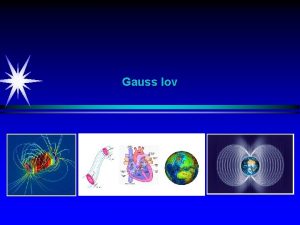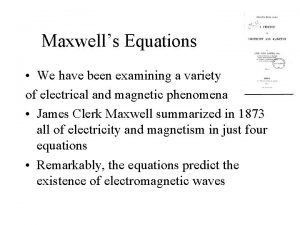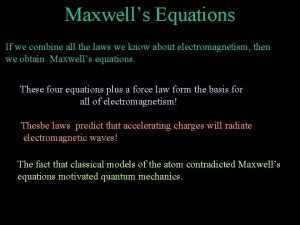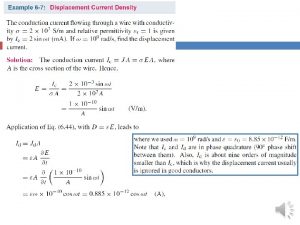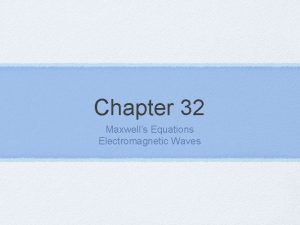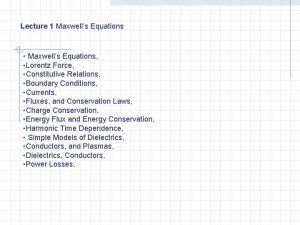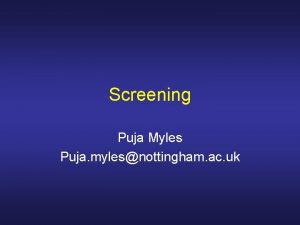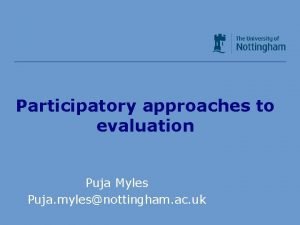Maxwells Equations Dr Puja Kumari Assistant Professor Dept












- Slides: 12

Maxwell’s Equations Dr. Puja Kumari Assistant Professor Dept. of Physics D. C. E. , Darbhanga

Maxwell’s equations of Electromagnetism • All relationships between electrostatics & magneto statics & their sources summarized by four equations. • Electromagnetic movement being conceptualised in form of wave. James Clerk Maxwell (1831 -1879)

Before Maxwell……… Gauss’s Law of Electrostatics: Electric Flux Gauss Divergence Theorem Gauss’s Law of Magneto statics: Magnetic Flux Gauss Divergence Theorem Magnetic fields do not begin or end at any point v The divergence of the B field is always zero through any volume. v Magnetic monopoles do not exist.

Before Maxwell……… Faraday’s law of Electromagnetic Induction: Stoke’s Theorem Ampere’s Law: Stoke’s Theorem

Four Equations All Together: (Gauss’s Law Electrostatics) (Gauss Law of Magneto statics) (Faraday’s law of EMI) (Ampere’s law) What did Maxwell do?

Maxwell the One who Realized the symmetry In Equation 3 rd and Non-symmetry in 4 th: From Faraday’s Law: On taking the divergence As divergence of curl is always zero. L. H. S. = R. H. S.

Maxwell the One who Realized the symmetry In Equation 3 rd and Non-symmetry in 4 th: From Ampere’s Law On taking the divergence As divergence of curl is always zero which led to. (But this is not always true) Equation of Continuity:

. . . lets take a look at charge flowing into a capacitor. . . B . . . when we derived Ampere’s Law we assumed constant current. . . B. . if the loop encloses one plate of the capacitor. . there is a problem … I = 0 Side view: (Surface is now like a bag: ) E E

Maxwell solved this problem by realizing that. . Inside the capacitor there must be an induced magnetic field. . . B E How? . Inside the capacitor there is a changing E B x x x E x x x x A changing electric field induces a magnetic field Therefore, Maxwell’s revision of Ampere’s Law becomes. . where Id is called the displacement current

Maxwell’s Equations: (Gauss’s Law Electrostatics) (Gauss’s Law of Magneto statics) (Faraday’s law of EMI) (Ampere’s law with Maxwell correction)

Outcomes: v. The time rate change of magnetic field produces electric field. v. The time rate of change of electric field produces magnetic field. v. The four coupled equations is reduced now to two uncoupled wave equations: Electrostatic Magneto statics Electromagnetism

K N A TH Y U O
